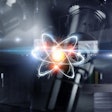CHICAGO - You’re excused if you did a double-take in front of the RSNA booth of nuclear medicine vendor ADAC Laboratories. The Milpitas, CA, company yesterday introduced a new gamma camera that uses a striking open-style design, with the system’s detector heads suspended from the ceiling rather than housed in a gantry.
ADAC hopes the system, called Skylight, will set a new standard for gamma camera flexibility, spurring the development of new applications for nuclear medicine. The company also hopes that Skylight will serve as the springboard for research into integrating nuclear medicine with other modalities.
ADAC began investigating radical new designs for its gamma cameras about two years ago, according to Mohamed Elmandjra, vice president of marketing for ADAC. At the time, the company’s competitors were introducing new dual-head gamma cameras with open gantries, a configuration that is more flexible than the ring-style design then used for ADAC’s flagship product, Genesys Vertex.
Since then ADAC has introduced an open-style dual-head camera, called Forte, that addresses its competitors directly. But the company also decided to develop a new gamma camera that takes open design to a new level, Elmandjra said.
With Skylight, ADAC placed the camera’s two detectors on overhead mounts that look like enlarged x-ray tube stands. The mounts are in turn attached to rails in the gamma camera suite, enabling the heads to move along the axis of the patient bed. ADAC calls the configuration a gantry-free design.
Because there is no gantry to impede patient movement, Skylight users will have unprecedented freedom in patient and detector positioning, Elmandjra said. Users will be able to position Skylight’s detector heads extremely close to patients, or over and under patients on gurneys. Each detector moves independently of the other, and users will even be able to image two patients at once, one with each detector.
In its RSNA booth, ADAC displayed Skylight in a mock-up of an interventional suite, with a CT scanner in the room. The display indicates that Skylight could be used in conjunction with other imaging modalities.
"We want to take the flexibility of nuclear medicine and take it beyond any pre-imagined level," Elmandjra said.
ADAC has been watching the development of hybrid scanners that combine nuclear medicine with modalities like x-ray and CT. But the company does not believe that hybrid imaging is advanced enough to determine which technology would be best suited with nuclear medicine. Skylight’s design will enable nuclear medicine departments to site the system with any other modality, be it x-ray, CT, or MRI, Elmandjra said.
Skylight can be used with any of ADAC’s existing detector designs – in the RSNA booth, it is being displayed with extra-large field-of-view detectors. The system is capable of SPECT imaging, as well as ADAC’s Molecular Coincidence Detection high-energy imaging technique.
The Skylight program is still in the early commercialization phase, and ADAC has yet to make any alpha installations. The company believes the system is probably a year to 18 months from market. It’s too early to estimate the list price at which Skylight will be sold, Elmandjra said.
By Brian CaseyAuntMinnie.com staff writer
November 30, 1999
















